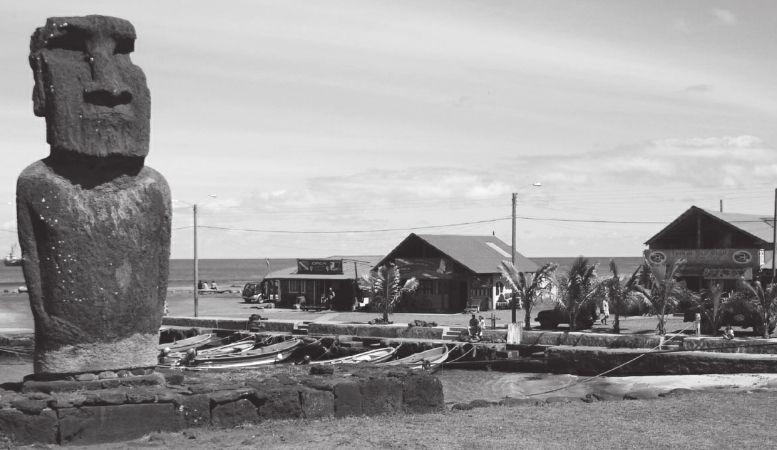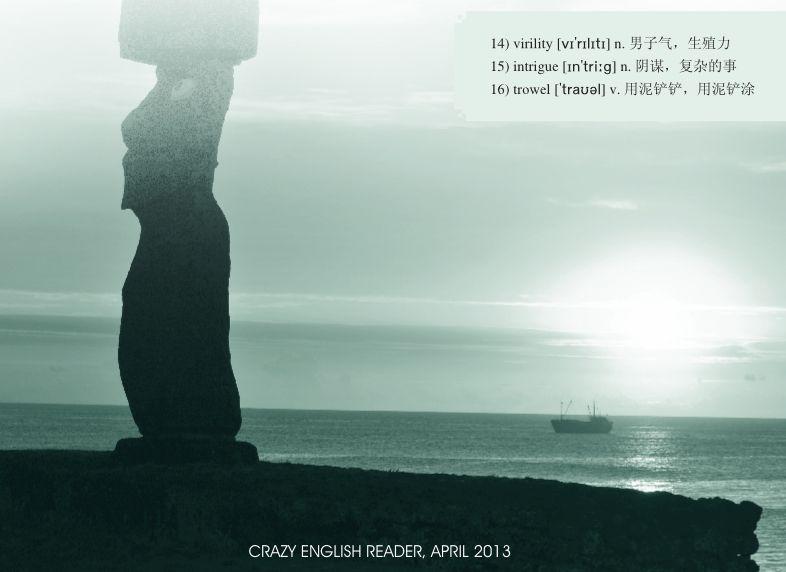快意复活节岛:失落于世界尽头的静美
2013-05-21byGabrielO’Rorke
by Gabriel ORorke



Some have tattoos, some are fat, some are thin,
and we think we can tell the relations of some of them today by the 1)distinctive noses you see around town,” says Patricia Vargas.
I am on Easter Island, and Patricia—an 2)archaeologist, and one of the founders of Chiles Architectural Travel Service (ATS)—is talking about moai, the famous stone 3)monolith statues, carved out of the mountains by the islands 4)Neolithic inhabitants in the 12th to 14th centuries.
Patricias life has revolved around these astonishing creations for the last 36 years. They seem a worthy cause.
Despite being on the worlds most remote inhabited island—a volcanic 5)archipelago 2,300 miles west of Chile—the moai attract more than 50,000 visitors each year.
My destination is five-star Posada de Mike Rapu hotel, which sits on the south-eastern side of the island, five miles from the main village of Hanga Roa. Large windows frame views that seem to stretch wider than any normal 6)panorama, and the 30 bedrooms overlook little but fields and sea. The only sign of life are horses and cows which roam free, munching on grass and wandering between the coral trees.
I soon discover it is no unusual thing to see more 7)quadrupeds than 8)bipeds here—as Easter Island has more horses than people (the local Rapa Nui population is just 4,000). However, I am here to see the statues, of which there are almost 1,000—and only one of which has legs.
This is Ahu Tukuturi who kneels on the hillside of Rano Raraku—the 9)quarry of volcanic tuffstone which gave birth to the entire race of moai.
“Different statues in different parts of the island belonged to the different clans that lived there,”explains Alex Searle, who is also an ATS guide.
What this means is that, if your clan lived on the far side, you had to transport your moai across the 64-square-mile island. Multiple theories have emerged over the years about how this supernatural feat was achieved.
“Some people thought they were lined up along the rim and fired into position when the volcano erupted,” says Alex. “Others say aliens moved them, and some say they walked.”
More than 400 figures loom out of the grass, carefully carved to completion. Gazing at them, it occurs to me that they look as though they were 10)petrified as they walked. Or perhaps that should be“staggered” —the irregular angles at which they jut out of the grass makes them look somewhat 11)tipsy.
他们中有的刻有文身,有的胖,有的瘦,我们觉得可以根据他们鼻子的特点辨别出镇上一些人之间的关系” ,帕特里夏·瓦尔加斯说道。
我现在身处复活岛。帕特里夏是一位考古学家,也是智利的建筑旅游服务组织(ATS)的创始人之一。她正在介绍“摩艾”这举世闻名的巨石群,这些石像是在公元12至14世纪由岛上新石器时代的住民在山上开凿而成。
在过去的36年里,帕特里夏的生活轨迹都围绕着这些惊世之作而展开。这一切看来都是值得的。
尽管位于世上最人迹罕至的海岛之上——智利以西2300英里的一个火山群岛上,摩艾石像还是每年吸引了超过五万名旅客前往观摩。
我的目的地是五星酒店Posada de Mike Rapu,坐落在岛的东南一隅,距离当地的主要村庄安加罗阿五英里。
透过巨大的窗户,眼底的景色似乎要比任何景宽都要开阔,30个酒店房间俯瞰的只是农田与海景。在这片景观中,唯一的生命迹象是马和奶牛,他们自由自在地徜徉在草地上,穿梭于刺桐之间。
我很快就发现,这里的四肢动物比两肢动物要多,因为复活岛上的马的数量比人口还要多(当地的居民仅为4000人)。然而,我来这要看的石像,近1000座,其中只有一座是有腿的。
这就是阿胡图库图日巨像,跪在拉诺拉拉库山巅,所有这些巨像都是取材自这座火山上的凝灰岩。
“岛上各处的不同石像分属于不同的宗族”,艾利克斯·瑟尔说,他也是ATS的一位导赏员。
这意味着,如果你们的宗族住在边远的地方,那你们就要穿越64平方英里的海岛,把你们的巨像从这一头搬到另一头。多年来,关于这种超自然的事情是怎么完成的,人们有着各种各样的说法。
“有人认为这些石像被排成一排,然后在火山爆发的时候被弹到现在的位置,”艾利克斯说,“但有人说是外星人把他们搬到这儿来的,更有人说,是石像自己‘走到这儿的。”
四百余座石像伫立在草地上,雕工精细,浑然天成。凝望着他们,我觉得他们看起来像是在行走时突然被石化而成的。又或者应该说,他们有点“步履蹒跚”的样子——从不同角度来看,他们在草地中显露出的形态有点像酒后的蹒跚。
As we explore the quarry, the entrails of the mountain gape open. On closer inspection, figures emerge from the stone. The statues were carved out of the hillside, chipped away with 12)basalt stone picks until they formed figurines.
“They were constantly changing and making new statues, recycling older ones, constantly reviewing and updating,” says Alex.
“These statues were their ancestors. To them, they were like vessels.”
One unfinished figure, which still lies in the hillside, measures a staggering 21 metres in length, its front carved out but its back not yet freed from the grip of the mountain. The tallest statue on the island stands at 12 metres so this 13)double-decker moai is ambitious to say the least.
Perhaps this example of over-reaching is a clue as to why these craftsmen upped and went. How and why the moai were transported and erected is one of the worlds mysteries, and the longer I spend on Easter Island, the more I feel the Rapa Nui people like it this way.
随着我们在岛上的观光愈发深入,这时山的内部结构也呈现眼前了。走近一看,一座座的巨像从山石上显现。这些石像沿着山壁雕刻成形,都是人们用玄武岩石镐一点点地开凿而成的。
“这些石像的形态千变万化。人们在不断地雕刻新的石像,将旧的石料循环再用,不断地审视以往的作品,然后推陈出新,”艾利克斯说。
“这些石像就是他们的祖先。对他们来说,石像就如同容器一般。”
一座还未完成的石像躺在山边,长度竟有惊人的21米。它的前半部分已经雕琢完成,后半部却还没从山体分离。目前岛上最高的石像有12米,毫不夸张地说,这座两层的石像堪称雄心之作。
也许这座野心巨作能为我们揭开谜团提供线索——为什么这些石匠突然有一天就消失了。这些石像到底是如何以及为何被搬动和安放到这里的?这是当今世界的一大未解之谜。我在岛上停留的时间越长,我越觉得岛上的居民更希望这个谜没有解开的一天。
Today, most archaeologists concede that wooden sledges were used to transport the statues to their positions around the coast(about 400 were lined up along platforms). Naturally, the larger ones were destined for closer locations.
As if in proof of this, on the coast below the quarry stands a line of 15 moai.
“For one minute close your eyes and imagine you are in the early 18th century when the Europeans arrived,” says Patricia. “Not much has changed in the landscape since then.”
Yet, difficulty and conflict lie between us and this lost era.
When the Europeans arrived, the statues were standing. But they found an island in hard times. When a Dutch expedition landed in 1722, this was the Rapa Nuis first contact with outsiders. The next visit wasnt to be for another 50 years, when the Spanish came.
“Before these visits, they thought they were the only people surviving in the universe,” says Patricia. “Imagine the impact of Europeans: it would have been like ET arriving in Central Park!”
The descriptions taken down by the Spanish tell a very different tale from the healthy community described by the Dutch—and it is clear this dense population of 20,000 was struggling to survive with few resources, scarce water and over-worked land.
今天,大多数的建筑学家都相信,古人是用木橇沿着海岸线将这些巨石搬运到现在的位置的(大约400座石像是依序排列在平台之上的)。大的石像自然是安放在较近的位置。
山下海边排列的15座石像似乎就证明了这一点。
“用一分钟的时间,闭上双眼,想象你是在18世纪初,欧洲人刚刚来到这里的时候,”帕特里夏说,“从那以后,这里的景观就没有发生过什么大的变化。”
然而,横亘在我们与那逝去的年代之间的,是争议和分歧。
欧洲人刚到此地时,石像已经存在了。但他们是在艰难时世发现这座岛的。当一个荷兰远征队在1722年登上这座岛时,那是复活节岛第一次与外界接触。到下一次再有外人登岛,已是五十年之后,这次来的是西班牙人。
“在这两次与外界接触之前,岛上的人以为他们是宇宙间唯一生存的人类,”帕特里夏说。“想象一下欧洲人出现在岛上居民眼前的情景:他们就像外星人出现在中央公园那样!”
西班牙人流传下来的记录所述说的情况与荷兰人形容的“健康的社区”有所不同——显然,因为资源有限、淡水不足和土地贫瘠,当时岛上的两万名居民正苦苦挣扎于生存的边缘。
Within a hundred years, not one moai was left standing and a new cult had taken over—one based more on 14)virility than piety, and called the Birdman Cult. The chief was chosen by means of an annual race which involved scrambling down the cliff-top of Orongo and swimming out to a small island, fetching an egg and returning with it intact.
The result of so many bygone customs, cultures and traditions is that you can hardly take a step on Easter Island without coming across an archaeological site. There are 20,000 across the island, and of the 1,000 moai, only 30 have been reerected.
This is only the tip of the iceberg—but part of the 15)intrigue of Easter Island lies in not knowing exactly what its history held.
Many people report strange feelings when they set foot on this almost mythical island (my dreams were peculiar to say the least). And although we can only touch the surface, what better way to do so than under the eye of the very people who brushed, 16)troweled and uncovered the moai.
在后来的一百年间,没有一座石像幸存下来,取而代之的是另一种崇拜——对身强力壮的崇拜比宗派孝道更盛行,被称为鸟人崇拜。岛上居民每年通过竞赛选出首领。参赛者必须要从奥朗戈山崖顶端爬下,游至一座小岛上,拿到一枚鸡蛋并将它完整无缺地带回才能当选为首领。
在这里,久远的习俗、文化和传统如此丰富,你在岛上几乎每走一步就会看到一个考古点。目前岛上共有两万个考古点,在1000座石像中,只有30座是重新竖立的。
这只是冰山一角——神秘的复活节岛到底拥有怎样的历史,仍有很多疑点无法解释。
很多人都描述过踏足这个神秘之岛的奇妙感觉(毫不夸张地说,我做的梦也是奇异的)。然而,即使只能触及皮毛,除了借由这些开掘摩艾的考古学家之眼,我们还有什么更好的办法来揭秘历史呢?
